Lãnh đạo chuyển đổi và quá trình tham gia sáng tạo trong doanh nghiệp viễn thông Việt Nam: Vai trò trung gian của trao quyền tâm lý
hả năng lãnh đạo ảnh hưởng đến sự tham gia của nhân viên vào các hoạt động sáng tạo,
đặc biệt là những hoạt động trong ngành viễn thông, trước sự đổi mới công nghệ liên tục. Nghiên
cứu này tập trung vào việc hiểu mối quan hệ của lãnh đạo chuyển đổi, quá trình tham gia sáng
tạo và trao quyền tâm lý. Kết hợp cả phương pháp định tính và định lượng với quy mô mẫu là
420 nhân viên doanh nghiệp viễn thông, kết quả nghiên cứu cho thấy lãnh đạo chuyển đổi có
mối quan hệ tích cực với quá trình tham gia sáng tạo và trao quyền tâm lý, trao quyền tâm lý có
tác động tích cực đến quá trình tham gia sáng tạo, đồng thời, trao quyền tâm lý đóng một vai trò
trung gian trong mối quan hệ giữa lãnh đạo chuyển đổi và quá trình tham gia sáng tạo. Dựa
trên kết quả nghiên cứu, tác giả đưa ra các đề xuất cho nhà quản lý tại các doanh nghiệp viễn
thông Việt Nam bao gồm: phát triển năng lực lãnh đạo chuyển đổi bằng cách trao quyền và
khuyến khích sự tham gia của nhân viên vào việc ra quyết định và phát triển các ý tưởng mới,
phát triển các cách thức để trao quyền cho nhân viên về mặt cảm xúc.
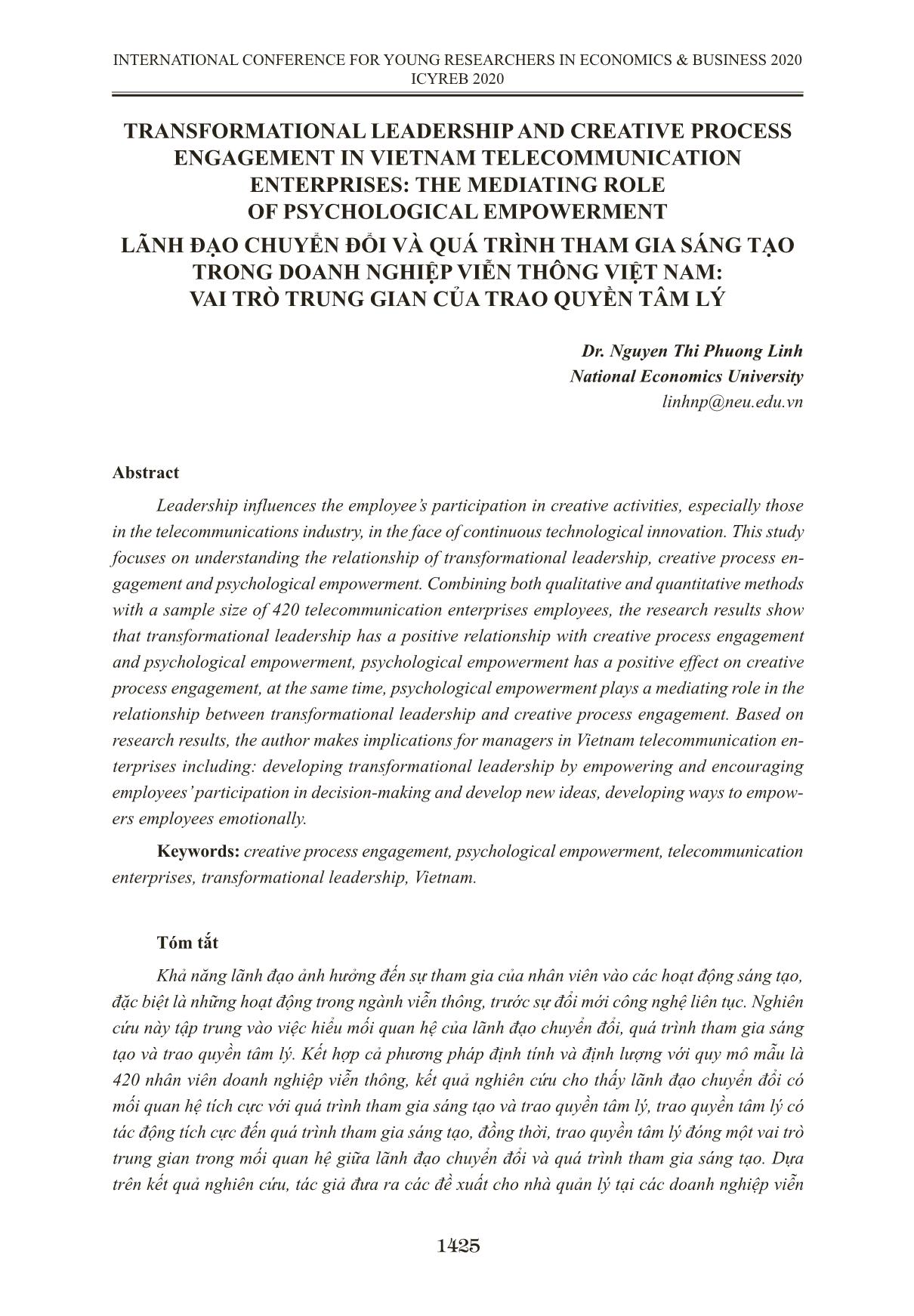
Trang 1
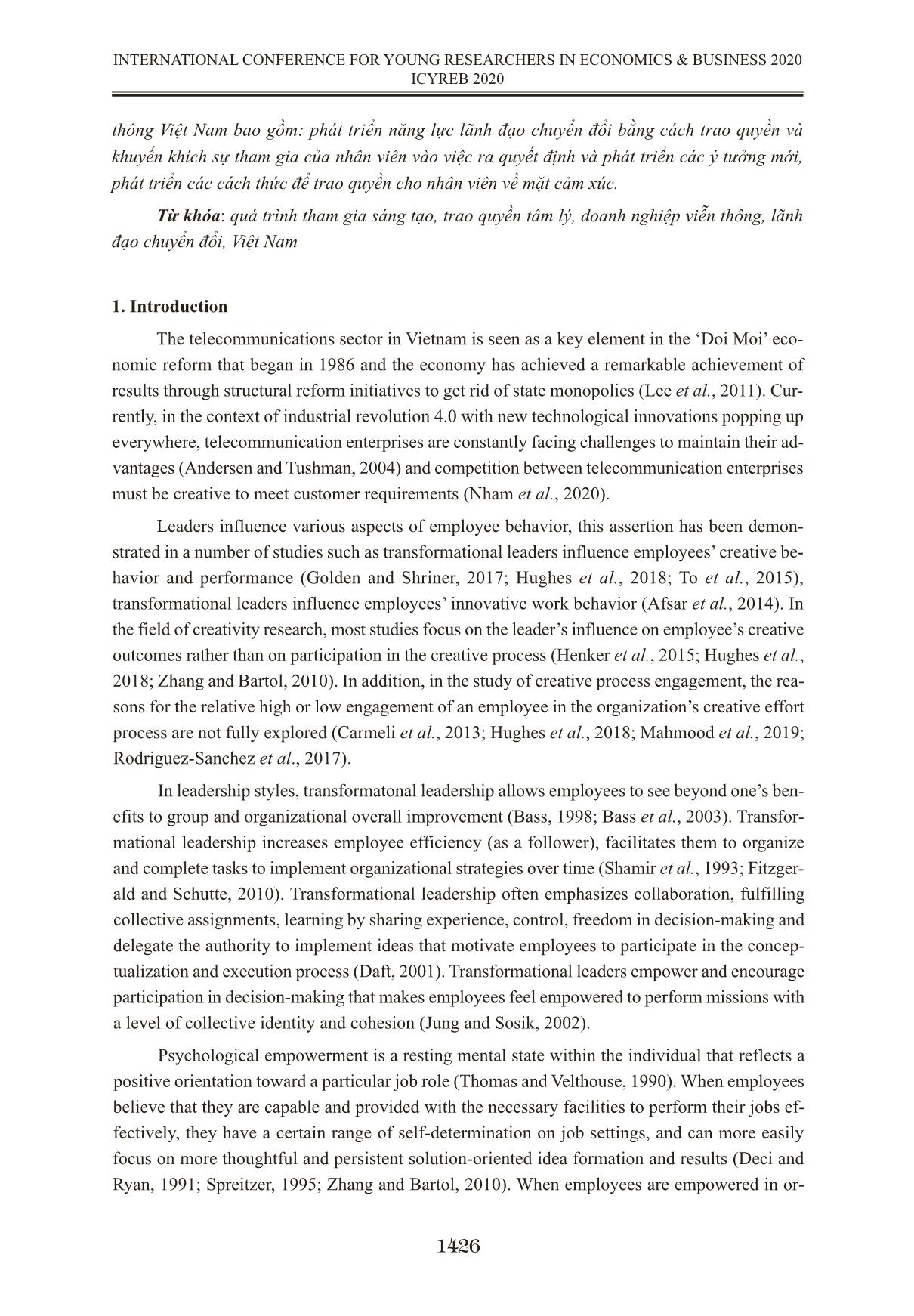
Trang 2
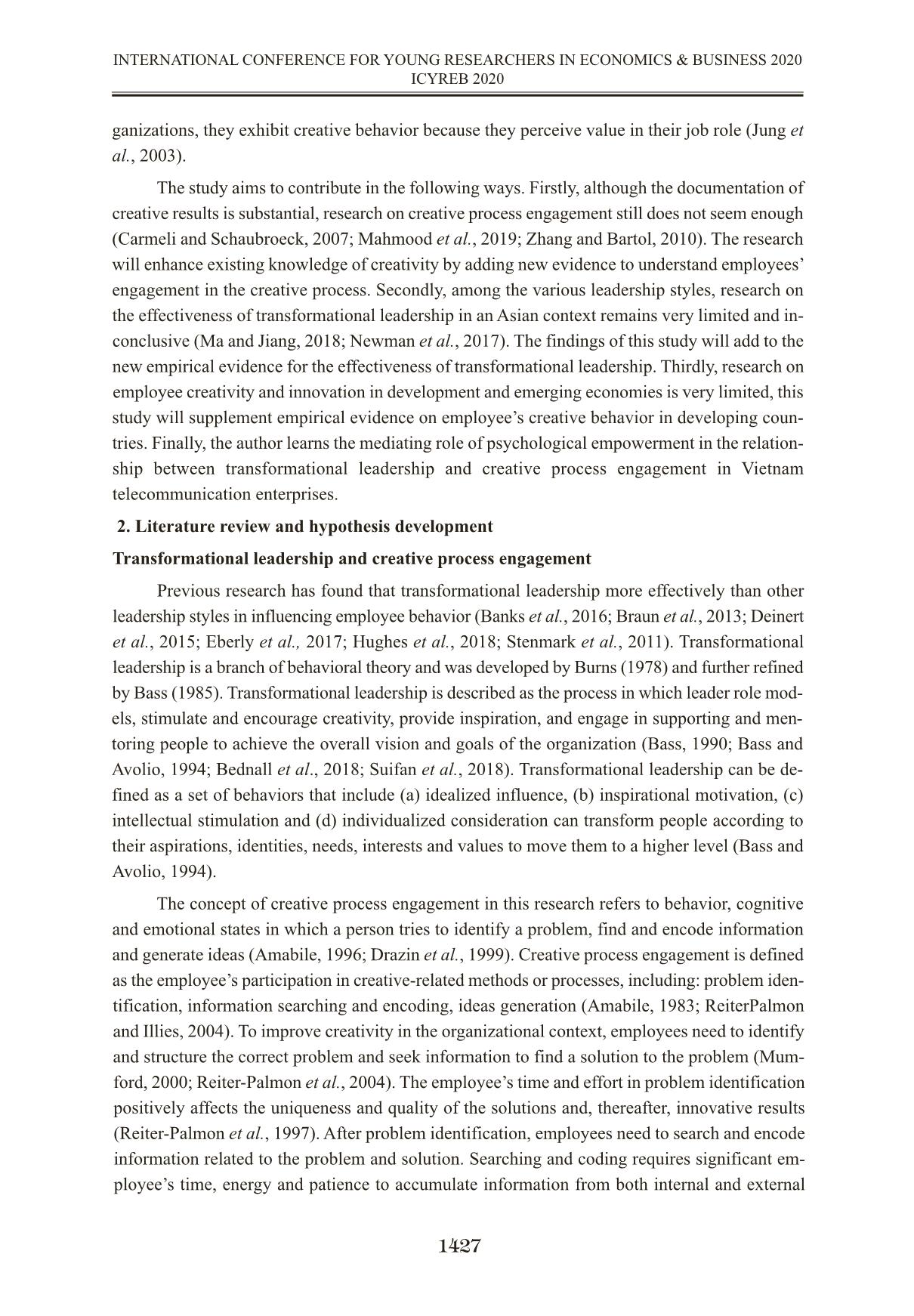
Trang 3
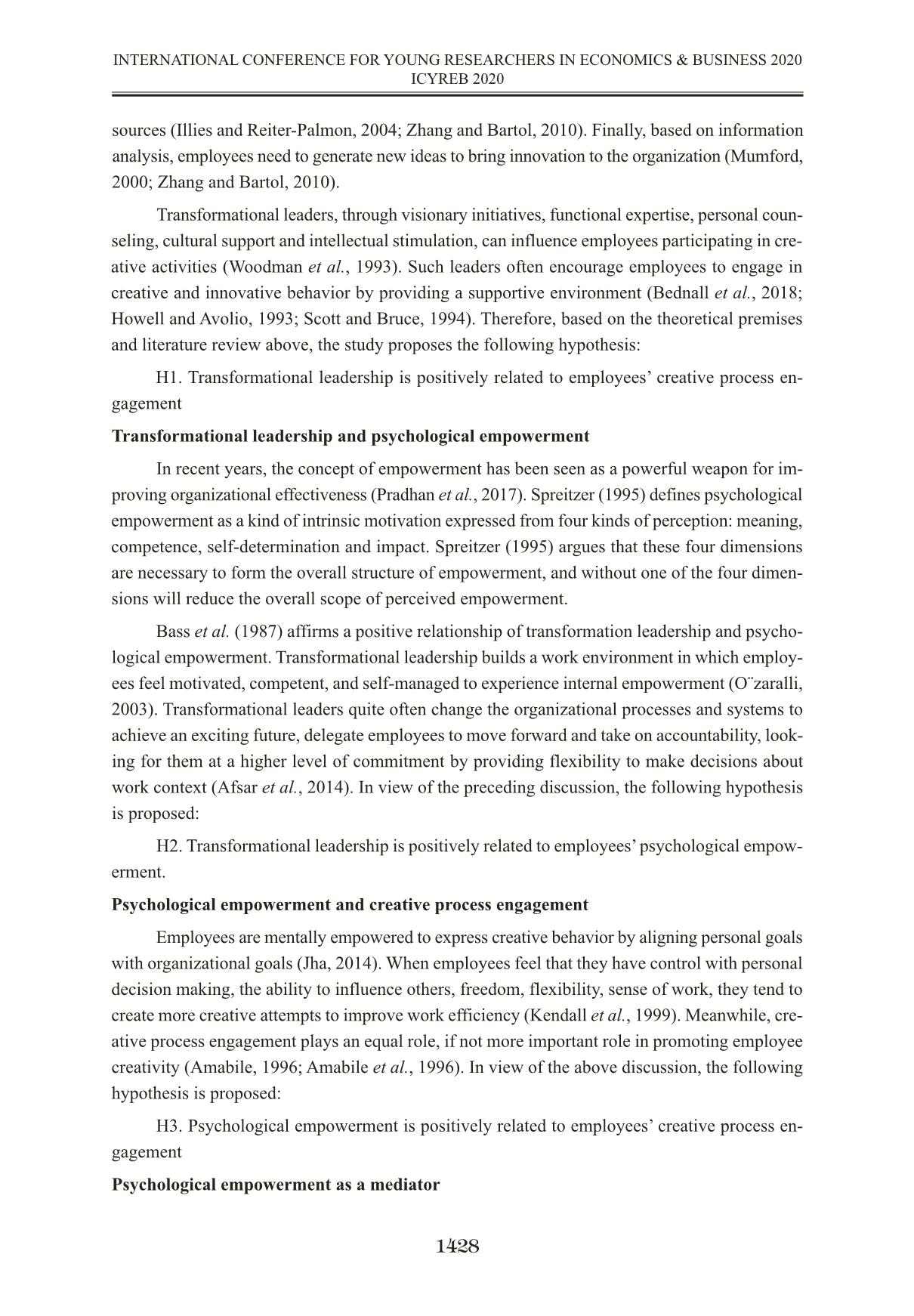
Trang 4
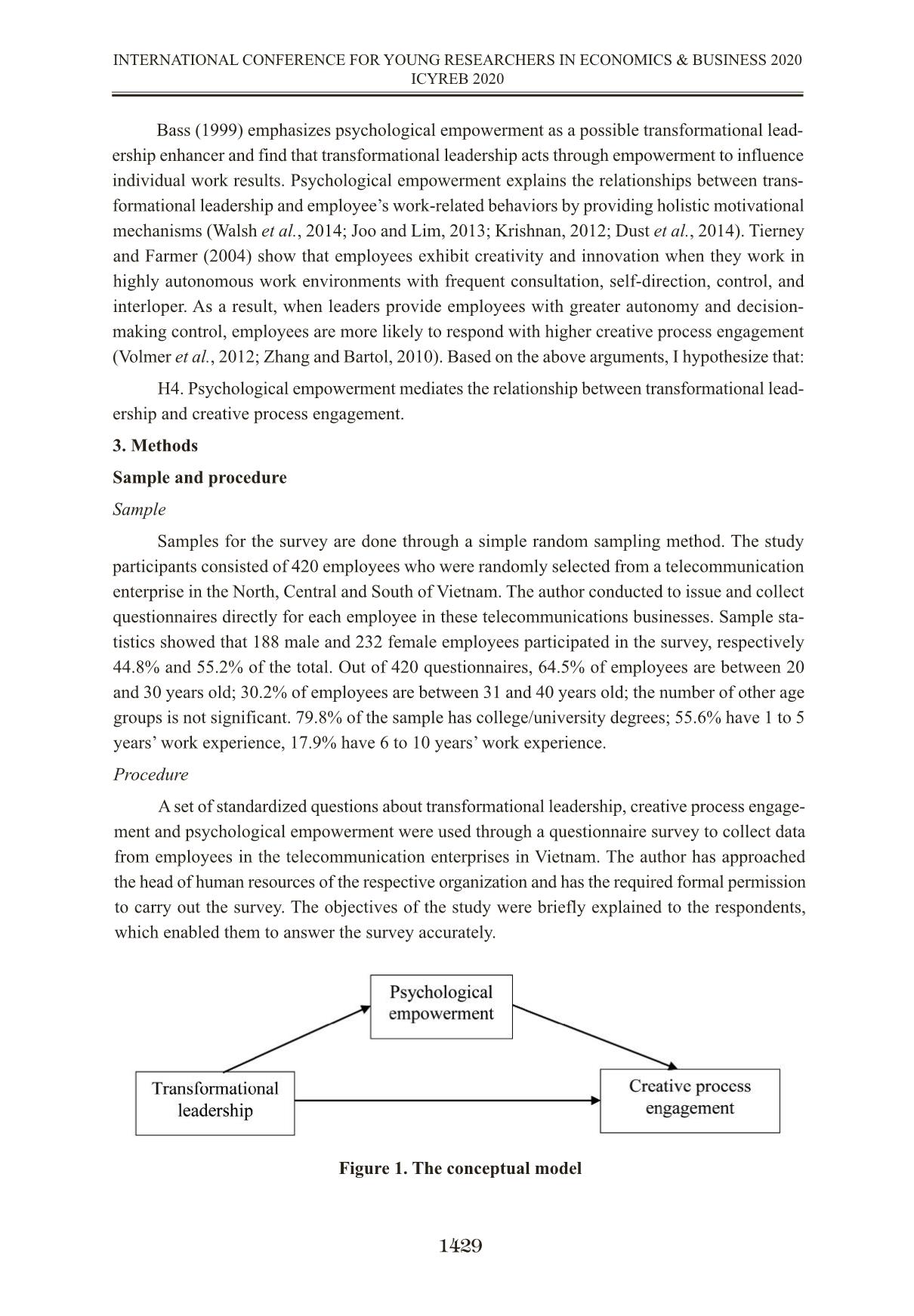
Trang 5
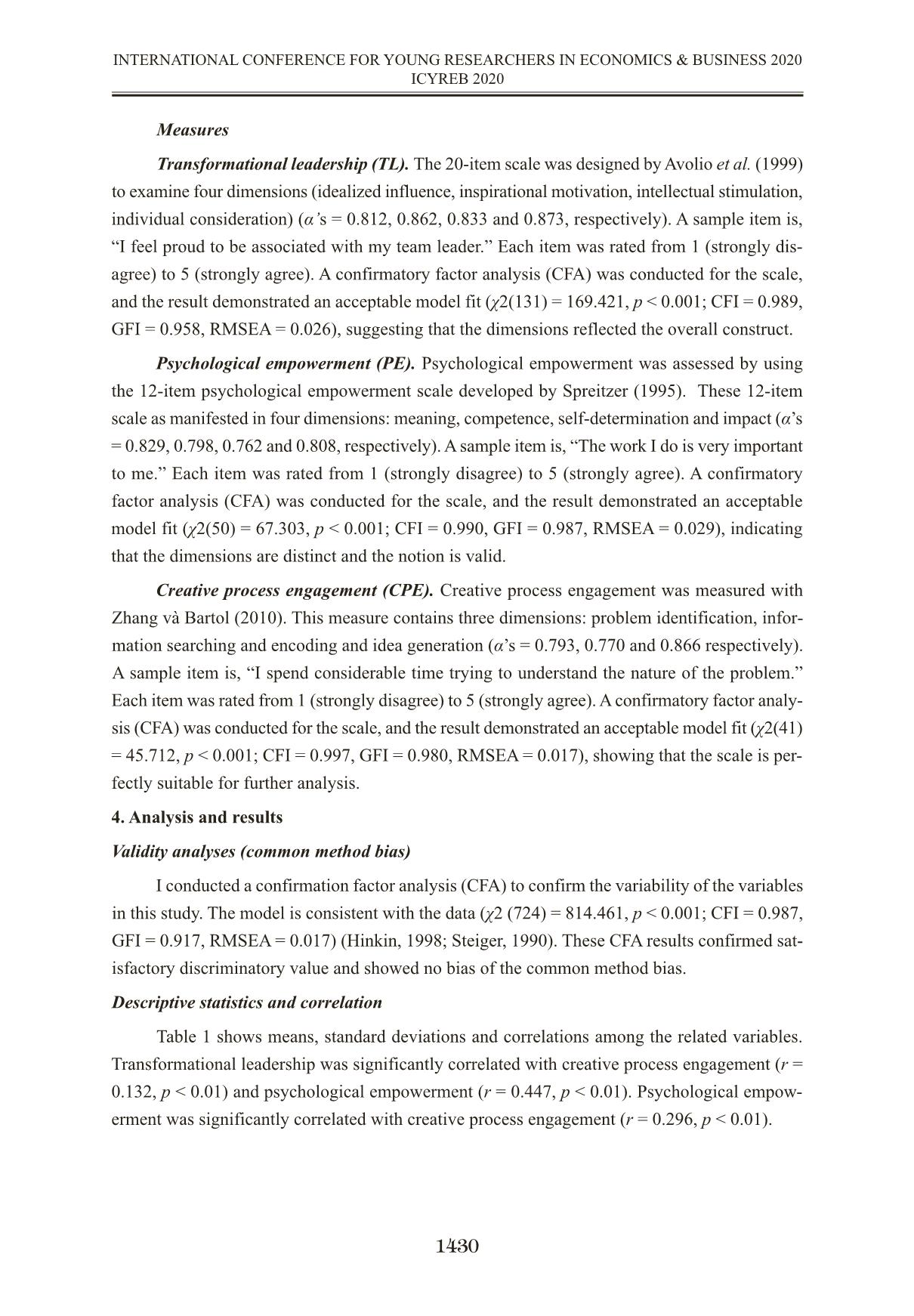
Trang 6
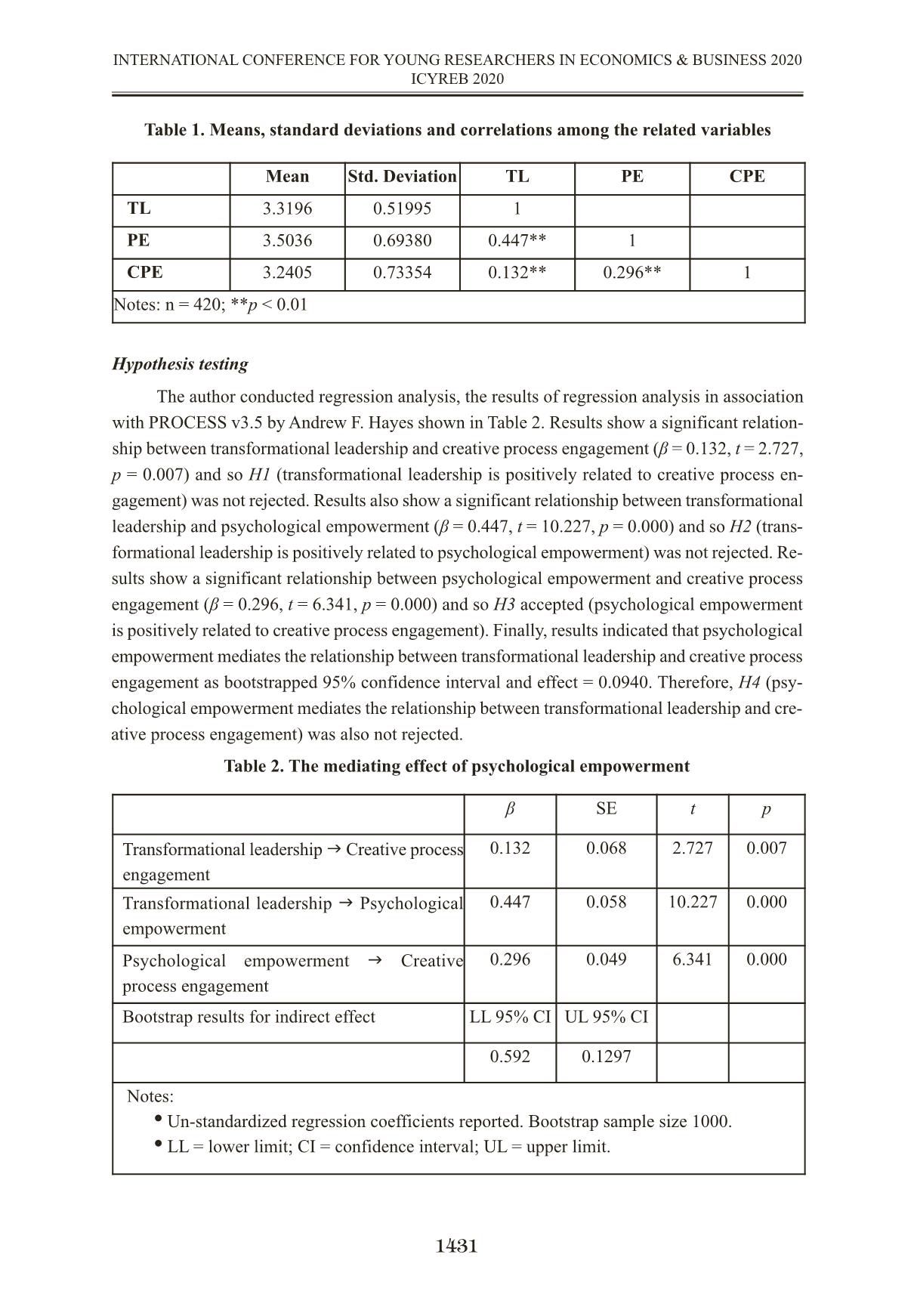
Trang 7
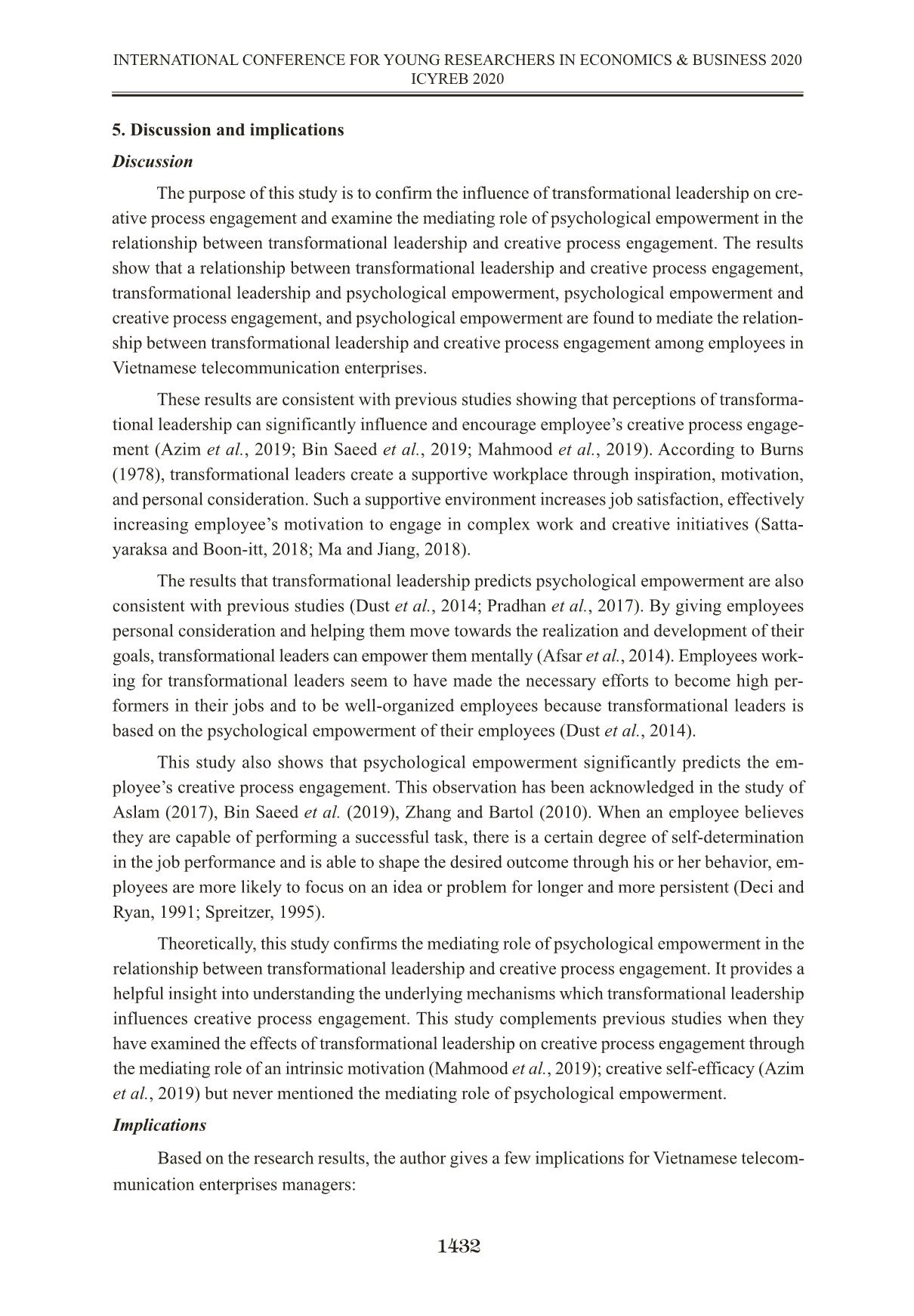
Trang 8
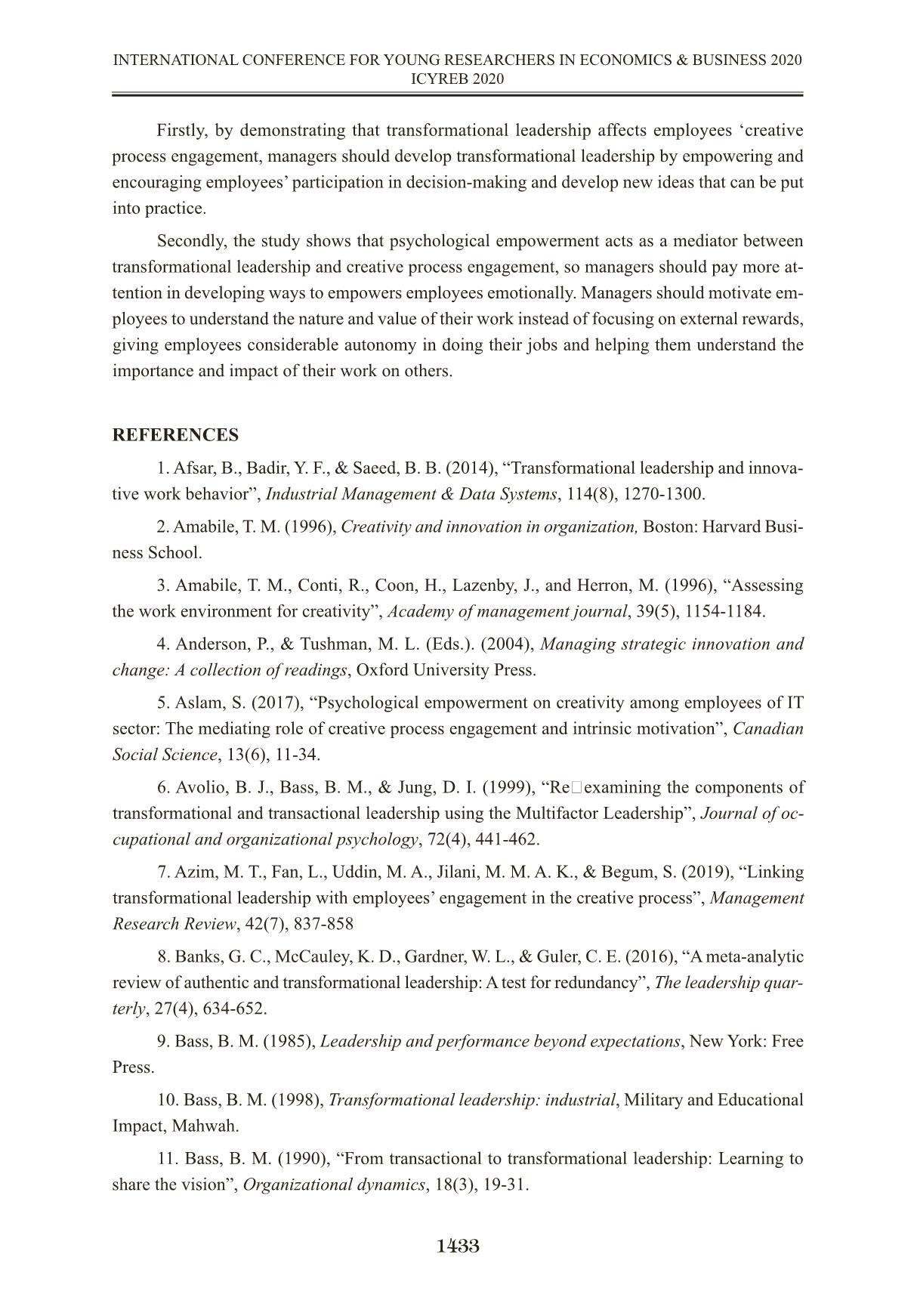
Trang 9
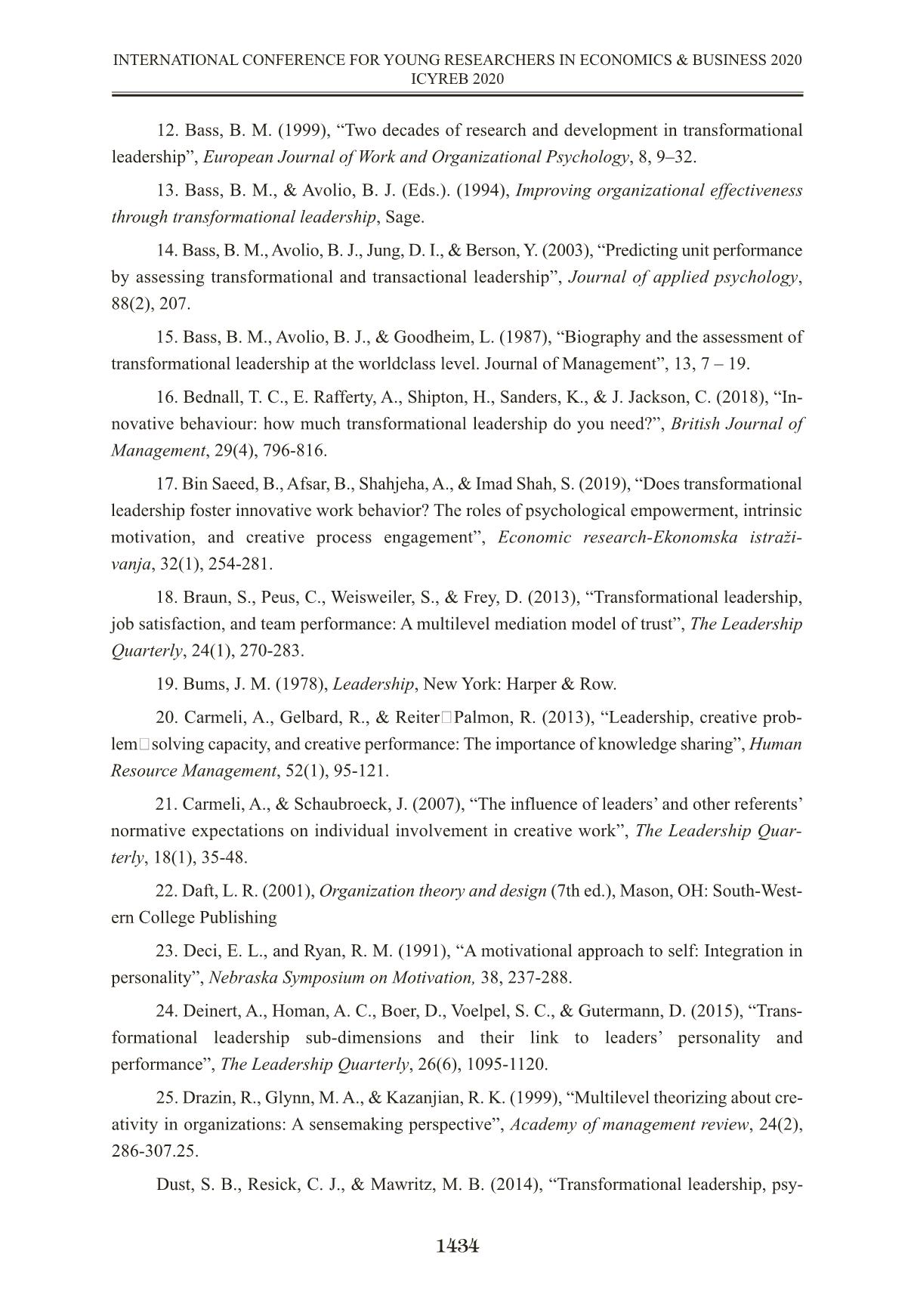
Trang 10
Tải về để xem bản đầy đủ
Tóm tắt nội dung tài liệu: Lãnh đạo chuyển đổi và quá trình tham gia sáng tạo trong doanh nghiệp viễn thông Việt Nam: Vai trò trung gian của trao quyền tâm lý
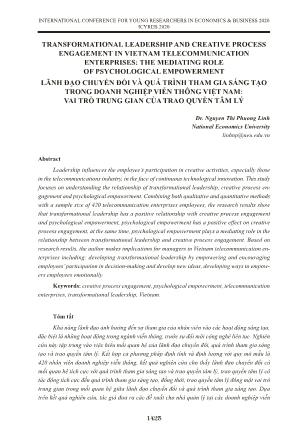
TRANSFORMATIONAL LEADERSHIP AND CREATIVE PROCESS ENGAGEMENT IN VIETNAM TELECOMMUNICATION ENTERPRISES: THE MEDIATING ROLE OF PSYCHOLOGICAL EMPOWERMENT LÃNH ĐẠO CHUYỂN ĐỔI VÀ QUÁ TRÌNH THAM GIA SÁNG TẠO TRONG DOANH NGHIỆP VIỄN THÔNG VIỆT NAM: VAI TRÒ TRUNG GIAN CỦA TRAO QUYỀN TÂM LÝ Dr. Nguyen Thi Phuong Linh National Economics University linhnp@neu.edu.vn Abstract Leadership influences the employee’s participation in creative activities, especially those in the telecommunications industry, in the face of continuous technological innovation. This study focuses on understanding the relationship of transformational leadership, creative process en- gagement and psychological empowerment. Combining both qualitative and quantitative methods with a sample size of 420 telecommunication enterprises employees, the research results show that transformational leadership has a positive relationship with creative process engagement and psychological empowerment, psychological empowerment has a positive effect on creative process engagement, at the same time, psychological empowerment plays a mediating role in the relationship between transformational leadership and creative process engagement. Based on research results, the author makes implications for managers in Vietnam telecommunication en- terprises including: developing transformational leadership by empowering and encouraging employees’ participation in decision-making and develop new ideas, developing ways to empow- ers employees emotionally. Keywords: creative process engagement, psychological empowerment, telecommunication enterprises, transformational leadership, Vietnam. Tóm tắt Khả năng lãnh đạo ảnh hưởng đến sự tham gia của nhân viên vào các hoạt động sáng tạo, đặc biệt là những hoạt động trong ngành viễn thông, trước sự đổi mới công nghệ liên tục. Nghiên cứu này tập trung vào việc hiểu mối quan hệ của lãnh đạo chuyển đổi, quá trình tham gia sáng tạo và trao quyền tâm lý. Kết hợp cả phương pháp định tính và định lượng với quy mô mẫu là 420 nhân viên doanh nghiệp viễn thông, kết quả nghiên cứu cho thấy lãnh đạo chuyển đổi có mối quan hệ tích cực với quá trình tham gia sáng tạo và trao quyền tâm lý, trao quyền tâm lý có tác động tích cực đến quá trình tham gia sáng tạo, đồng thời, trao quyền tâm lý đóng một vai trò trung gian trong mối quan hệ giữa lãnh đạo chuyển đổi và quá trình tham gia sáng tạo. Dựa trên kết quả nghiên cứu, tác giả đưa ra các đề xuất cho nhà quản lý tại các doanh nghiệp viễn 1425 INTERNATIONAL CONFERENCE FOR YOUNG RESEARCHERS IN ECONOMICS & BUSINESS 2020 ICYREB 2020 thông Việt Nam bao gồm: phát triển năng lực lãnh đạo chuyển đổi bằng cách trao quyền và khuyến khích sự tham gia của nhân viên vào việc ra quyết định và phát triển các ý tưởng mới, phát triển các cách thức để trao quyền cho nhân viên về mặt cảm xúc. Từ khóa: quá trình tham gia sáng tạo, trao quyền tâm lý, doanh nghiệp viễn thông, lãnh đạo chuyển đổi, Việt Nam 1. Introduction The telecommunications sector in Vietnam is seen as a key element in the ‘Doi Moi’ eco- nomic reform that began in 1986 and the economy has achieved a remarkable achievement of results through structural reform initiatives to get rid of state monopolies (Lee et al., 2011). Cur- rently, in the context of industrial revolution 4.0 with new technological innovations popping up everywhere, telecommunication enterprises are constantly facing challenges to maintain their ad- vantages (Andersen and Tushman, 2004) and competition between telecommunication enterprises must be creative to meet customer requirements (Nham et al., 2020). Leaders influence various aspects of employee behavior, this assertion has been demon- strated in a number of studies such as transformational leaders influence employees’ creative be- havior and performance (Golden and Shriner, 2017; Hughes et al., 2018; To et al., 2015), transformational leaders influence employees’ innovative work behavior (Afsar et al., 2014). In the field of creativity research, most studies focus on the leader’s influence on employee’s creative outcomes rather than on participation in the creative process (Henker et al., 2015; Hughes et al., 2018; Zhang and Bartol, 2010). In addition, in the study of creative process engagement, the rea- sons for the relative high or low engagement of an employee in the organization’s creative effort process are not fully explored (Carmeli et al., 2013; Hughes et al., 2018; Mahmood et al., 2019; Rodriguez-Sanchez et al., 2017). In leadership styles, transformatonal leadership allows employees to see beyond one’s ben- efits to group and organizational overall improvement (Bass, 1998; Bass et al., 2003). Transfor- mational leadership increases employee efficiency (as a follower), facilitates them to organize and complete tasks to implement organizational strategies over time (Shamir et al., 1993; Fitzger- ald and Schutte, 2010). Transformational leadership often e ... s engagement. This observation has been acknowledged in the study of Aslam (2017), Bin Saeed et al. (2019), Zhang and Bartol (2010). When an employee believes they are capable of performing a successful task, there is a certain degree of self-determination in the job performance and is able to shape the desired outcome through his or her behavior, em- ployees are more likely to focus on an idea or problem for longer and more persistent (Deci and Ryan, 1991; Spreitzer, 1995). Theoretically, this study confirms the mediating role of psychological empowerment in the relationship between transformational leadership and creative process engagement. It provides a helpful insight into understanding the underlying mechanisms which transformational leadership influences creative process engagement. This study complements previous studies when they have examined the effects of transformational leadership on creative process engagement through the mediating role of an intrinsic motivation (Mahmood et al., 2019); creative self-efficacy (Azim et al., 2019) but never mentioned the mediating role of psychological empowerment. Implications Based on the research results, the author gives a few implications for Vietnamese telecom- munication enterprises managers: 1432 INTERNATIONAL CONFERENCE FOR YOUNG RESEARCHERS IN ECONOMICS & BUSINESS 2020 ICYREB 2020 Firstly, by demonstrating that transformational leadership affects employees ‘creative process engagement, managers should develop transformational leadership by empowering and encouraging employees’ participation in decision-making and develop new ideas that can be put into practice. Secondly, the study shows that psychological empowerment acts as a mediator between transformational leadership and creative process engagement, so managers should pay more at- tention in developing ways to empowers employees emotionally. Managers should motivate em- ployees to understand the nature and value of their work instead of focusing on external rewards, giving employees considerable autonomy in doing their jobs and helping them understand the importance and impact of their work on others. REFERENCES 1. Afsar, B., Badir, Y. F., & Saeed, B. B. (2014), “Transformational leadership and innova- tive work behavior”, Industrial Management & Data Systems, 114(8), 1270-1300. 2. Amabile, T. M. (1996), Creativity and innovation in organization, Boston: Harvard Busi- ness School. 3. Amabile, T. M., Conti, R., Coon, H., Lazenby, J., and Herron, M. (1996), “Assessing the work environment for creativity”, Academy of management journal, 39(5), 1154-1184. 4. Anderson, P., & Tushman, M. L. (Eds.). (2004), Managing strategic innovation and change: A collection of readings, Oxford University Press. 5. Aslam, S. (2017), “Psychological empowerment on creativity among employees of IT sector: The mediating role of creative process engagement and intrinsic motivation”, Canadian Social Science, 13(6), 11-34. 6. Avolio, B. J., Bass, B. M., & Jung, D. I. (1999), “Reexamining the components of transformational and transactional leadership using the Multifactor Leadership”, Journal of oc- cupational and organizational psychology, 72(4), 441-462. 7. Azim, M. T., Fan, L., Uddin, M. A., Jilani, M. M. A. K., & Begum, S. (2019), “Linking transformational leadership with employees’ engagement in the creative process”, Management Research Review, 42(7), 837-858 8. Banks, G. C., McCauley, K. D., Gardner, W. L., & Guler, C. E. (2016), “A meta-analytic review of authentic and transformational leadership: A test for redundancy”, The leadership quar- terly, 27(4), 634-652. 9. Bass, B. M. (1985), Leadership and performance beyond expectations, New York: Free Press. 10. Bass, B. M. (1998), Transformational leadership: industrial, Military and Educational Impact, Mahwah. 11. Bass, B. M. (1990), “From transactional to transformational leadership: Learning to share the vision”, Organizational dynamics, 18(3), 19-31. 1433 INTERNATIONAL CONFERENCE FOR YOUNG RESEARCHERS IN ECONOMICS & BUSINESS 2020 ICYREB 2020 12. Bass, B. M. (1999), “Two decades of research and development in transformational leadership”, European Journal of Work and Organizational Psychology, 8, 9–32. 13. Bass, B. M., & Avolio, B. J. (Eds.). (1994), Improving organizational effectiveness through transformational leadership, Sage. 14. Bass, B. M., Avolio, B. J., Jung, D. I., & Berson, Y. (2003), “Predicting unit performance by assessing transformational and transactional leadership”, Journal of applied psychology, 88(2), 207. 15. Bass, B. M., Avolio, B. J., & Goodheim, L. (1987), “Biography and the assessment of transformational leadership at the worldclass level. Journal of Management”, 13, 7 – 19. 16. Bednall, T. C., E. Rafferty, A., Shipton, H., Sanders, K., & J. Jackson, C. (2018), “In- novative behaviour: how much transformational leadership do you need?”, British Journal of Management, 29(4), 796-816. 17. Bin Saeed, B., Afsar, B., Shahjeha, A., & Imad Shah, S. (2019), “Does transformational leadership foster innovative work behavior? The roles of psychological empowerment, intrinsic motivation, and creative process engagement”, Economic research-Ekonomska istraži- vanja, 32(1), 254-281. 18. Braun, S., Peus, C., Weisweiler, S., & Frey, D. (2013), “Transformational leadership, job satisfaction, and team performance: A multilevel mediation model of trust”, The Leadership Quarterly, 24(1), 270-283. 19. Bums, J. M. (1978), Leadership, New York: Harper & Row. 20. Carmeli, A., Gelbard, R., & ReiterPalmon, R. (2013), “Leadership, creative prob- lem solving capacity, and creative performance: The importance of knowledge sharing”, Human Resource Management, 52(1), 95-121. 21. Carmeli, A., & Schaubroeck, J. (2007), “The influence of leaders’ and other referents’ normative expectations on individual involvement in creative work”, The Leadership Quar- terly, 18(1), 35-48. 22. Daft, L. R. (2001), Organization theory and design (7th ed.), Mason, OH: South-West- ern College Publishing 23. Deci, E. L., and Ryan, R. M. (1991), “A motivational approach to self: Integration in personality”, Nebraska Symposium on Motivation, 38, 237-288. 24. Deinert, A., Homan, A. C., Boer, D., Voelpel, S. C., & Gutermann, D. (2015), “Trans- formational leadership sub-dimensions and their link to leaders’ personality and performance”, The Leadership Quarterly, 26(6), 1095-1120. 25. Drazin, R., Glynn, M. A., & Kazanjian, R. K. (1999), “Multilevel theorizing about cre- ativity in organizations: A sensemaking perspective”, Academy of management review, 24(2), 286-307.25. Dust, S. B., Resick, C. J., & Mawritz, M. B. (2014), “Transformational leadership, psy- 1434 INTERNATIONAL CONFERENCE FOR YOUNG RESEARCHERS IN ECONOMICS & BUSINESS 2020 ICYREB 2020 chological empowerment, and the moderating role of mechanistic–organic contexts”, Journal of Organizational Behavior, 35(3), 413-433. 27. Eberly, M. B., Bluhm, D. J., Guarana, C., Avolio, B. J., & Hannah, S. T. (2017), “Staying after the storm: How transformational leadership relates to follower turnover intentions in extreme contexts”, Journal of Vocational Behavior, 102, 72-85. 28. Fitzgerald, S., & Schutte, N. S. (2010), “Increasing transformational leadership through enhancing selfefficacy”, Journal of Management Development, 29(5), 495-505. 29. Golden III, J. H., & Shriner, M. (2019), “Examining relationships between transfor- mational leadership and employee creative performance: The moderator effects of organizational culture”, The Journal of Creative Behavior, 53(3), 363-376. 30. Henker, N., Sonnentag, S., & Unger, D. (2015), “Transformational leadership and em- ployee creativity: the mediating role of promotion focus and creative process engagement”, Jour- nal of Business and Psychology, 30(2), 235-247. 31. Hinkin, T. R. (1998), “A brief tutorial on the development of measures for use in survey questionnaires”, Organizational research methods, 1(1), 104-121. 32. Howell, J. M., & Avolio, B. J. (1993), “Transformational leadership, transactional lead- ership, locus of control, and support for innovation: Key predictors of consolidated-business-unit performance”, Journal of applied psychology, 78(6), 891. 33. Hughes, D. J., Lee, A., Tian, A. W., Newman, A., & Legood, A. (2018), “Leadership, creativity, and innovation: A critical review and practical recommendations”, The Leadership Quarterly, 29(5), 549-569. 34. Illies, J. J., & Reiter-Palmon, R.O.N.I. (2004), “The effects of type and level of personal involvement on information search and problem solving”, Journal of Applied Social Psychol- ogy, 34(8), 1709-1729. 35. Jha, S. (2014), “Transformational leadership and psychological empowerment”, South Asian Journal of Global Business Research, 3(1), 18-35. 36. Jung, D. I., Chow, C., & Wu, A. (2003), “The role of transformational leadership in en- hancing organizational innovation: Hypotheses and some preliminary findings”, The leadership quarterly, 14(4-5), 525-544. 37. Jung, D. I., & Sosik, J. J. (2002), “Transformational leadership in work groups: The role of empowerment, cohesiveness, and collective-efficacy on perceived group performance”, Small group research, 33(3), 313-336. 38. Joo, B. K., & Lim, T. (2013), “Transformational leadership and career satisfaction: The mediating role of psychological empowerment”, Journal of Leadership & Organizational Stud- ies, 20(3), 316-326. 39. Kendall, P.C., Chu, B., Gifford, A., Hayes, C. and Nauta, M. (1999), “Breathing life into a manual: flexibility and creativity with manual-based treatments”, Cognitive and Behavioral Practice, 5(2), 177-198. 1435 INTERNATIONAL CONFERENCE FOR YOUNG RESEARCHERS IN ECONOMICS & BUSINESS 2020 ICYREB 2020 40. Krishnan, V. R. (2012), “Transformational leadership and personal outcomes: empow- erment as mediator”, Leadership & Organization Development Journal, 33(6), 550-563. 41. Lee, R. C., Low, K. H. P., Lum, S. L. D., & Poon, H. W. (2011), Telecommunications in Vietnam, APEC document. 42. Ma, X., & Jiang, W. (2018), “Transformational leadership, transactional leadership, and employee creativity in entrepreneurial firms”, The Journal of Applied Behavioral Sci- ence, 54(3), 302-324. 43. Mahmood, M., Uddin, M. A., & Fan, L. (2019), “The influence of transformational leadership on employees’ creative process engagement”, Management Decision, 57(3), 741-764. 44. Mumford, M. D. (2000), “Managing creative people: Strategies and tactics for innova- tion”, Human resource management review, 10(3), 313-351. 45. Newman, A., Schwarz, G., Cooper, B., & Sendjaya, S. (2017), “How servant leadership influences organizational citizenship behavior: The roles of LMX, empowerment, and proactive personality”, Journal of Business Ethics, 145(1), 49-62. 56. Nham, T. P., Tran, N. H., & Nguyen, H. A. (2020), “Knowledge sharing and innovation capability at both individual and organizational levels: An empirical study from Vietnam’s telecommunication companies”, Management & Marketing. Challenges for the Knowledge So- ciety, 15(2), 275-301. 47. O¨ zaralli, N. (2003), “Effects of transformational leadership on empowerment and team effectiveness”, Leadership & Organization Development Journal, 24(6), 335-344. 48. Pradhan, R. K., Panda, M., & Jena, L. K. (2017), “Transformational leadership and psychological empowerment”, Journal of Enterprise Information Management, 1-19. 49. Reiter-Palmon, R., & Illies, J. J. (2004), “Leadership and creativity: Understanding leadership from a creative problem-solving perspective”, The Leadership Quarterly, 15(1), 55-77. 50. Reiter-Palmon, R., Mumford, M. D., O’Connor Boes, J., & Runco, M. A. (1997), “Prob- lem construction and creativity: The role of ability, cue consistency, and active processing”, Cre- ativity Research Journal, 10(1), 9-23. 51. Rodríguez-Sánchez, A. M., Devloo, T., Rico, R., Salanova, M., & Anseel, F. (2017), “What makes creative teams tick? Cohesion, engagement, and performance across creativity tasks: a three-wave study”, Group & Organization Management, 42(4), 521-547. 52. Sattayaraksa, T., & Boon-itt, S. (2018), “The roles of CEO transformational leadership and organizational factors on product innovation performance”, European Journal of Innovation Management, 21(2), 227-249. 53. Scott, S. G., & Bruce, R. A. (1994), “Determinants of innovative behavior: A path model of individual innovation in the workplace”, Academy of management journal, 37(3), 580-607. 1436 INTERNATIONAL CONFERENCE FOR YOUNG RESEARCHERS IN ECONOMICS & BUSINESS 2020 ICYREB 2020 54. Shamir, B., House, R. J., & Arthur, M. B. (1993), “The motivational effects of charis- matic leadership: A self-concept based theory”, Organization science, 4(4), 577-594. 55. Spreitzer, G. M. (1995), “Psychological empowerment in the workplace: Dimensions, measurement, and validation”, Academy of management Journal, 38(5), 1442-1465. 56. Steiger, J. H. (1990), “Structural model evaluation and modification: An interval esti- mation approach”, Multivariate behavioral research, 25(2), 173-180. 57. Stenmark, C. K., Shipman, A. S., & Mumford, M. D. (2011), “Managing the innovative process: The dynamic role of leaders”, Psychology of aesthetics, creativity, and the arts, 5(1), 67. 58. Suifan, T. S., Abdallah, A. B., & Al Janini, M. (2018), “The impact of transformational leadership on employees’ creativity”, Management Research Review, 41(1), 113-132. 59. Thomas, K. W., & Velthouse, B. A. (1990), “Cognitive elements of empowerment: An “interpretive” model of intrinsic task motivation”, Academy of management review, 15(4), 666-681. 60. Tierney, P., & Farmer, S. M. (2004), “The Pygmalion process and employee creativ- ity”, Journal of Management, 30(3), 413-432. 61. To, M., Tse, H. and Ashkanasy, N. (2015), “A multi-level model of transformational leadership, affect, and creative process behavior in work teams”, The Leadership Quarterly, 26(4), 543-556. 62. Volmer, J., Spurk, D., & Niessen, C. (2012), “Leader–member exchange (LMX), job autonomy, and creative work involvement”, The Leadership Quarterly, 23(3), 456-465. 63. Walsh, M., Dupré, K., & Arnold, K. A. (2014), “Processes through which transforma- tional leaders affect employee psychological health”, German Journal of Human Resource Man- agement, 28(1-2), 162-172. 64. Woodman, R. W., Sawyer, J. E., & Griffin, R. W. (1993), “Toward a theory of organi- zational creativity”, Academy of management review, 18(2), 293-321. 65. Zhang, X., & Bartol, K. M. (2010), “Linking empowering leadership and employee creativity: The influence of psychological empowerment, intrinsic motivation, and creative process engagement”, Academy of management journal, 53(1), 107-128. 1437 INTERNATIONAL CONFERENCE FOR YOUNG RESEARCHERS IN ECONOMICS & BUSINESS 2020 ICYREB 2020
File đính kèm:
 lanh_dao_chuyen_doi_va_qua_trinh_tham_gia_sang_tao_trong_doa.pdf
lanh_dao_chuyen_doi_va_qua_trinh_tham_gia_sang_tao_trong_doa.pdf

